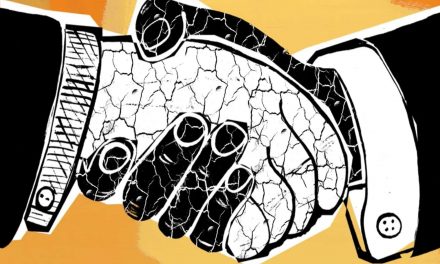
Despite the fact that on four separate occasions the person that a majority of Americans voted for lost the Presidential election, the United States stubbornly holds onto the Electoral College to select the President every four years.
Most of us, including those who argue for the system, are unaware of the role racism played in the creation of the Electoral College system. We claim to have democratic elections but in the most important election in the country, maybe the most important in the world, it is possible for the winner to lose the election.
In the minds of most, democratic elections mean that the majority wins. Not so in our nation. The Electoral College nullifies our system of one-person, one-vote. Electors select who becomes President and Vice President, not the popular vote of citizens. 538 Electors select the President. It takes a majority of 270 Electors to win the Presidential election currently.
As general rule, all of the Electors in a state vote for the person who wins a majority of the votes in the state. As a result of winning all or nearly all Electors, depending on the rules promulgated for Electors in each state, all votes cast lead to one person getting all of the votes by Electors.
Some states allow a different division of votes for Electors. Each state has its own rules about selecting Electors and how they are allowed to cast their votes. For example, during the 2016 election in Wisconsin, Donald Trump received about 22,000 more votes than Hillary Clinton, but each Elector’s vote from Wisconsin went to Donald Trump. He won 47.22 percent of the votes, while Clinton won 46.45 percent of the vote.
What this means in the bigger scheme of things, is that every vote cast in Wisconsin may as well have been cast for Donald Trump. He received 100 percent of the votes cast by Electors.
How is it possible that we have one, and only one, election in the country where the person who wins the most votes can lose? You must go back and learn the history of the country to determine the reason. Contrary to modern arguments for the Electoral College, it was not a system that was automatically adopted by the Founders. As the Constitutional Convention was taking place in 1787 in Philadelphia, debates ensued about election of the President. There were several ideas expressed by different people.
Some believed the people – meaning propertied white males – should directly elect the President. Some wanted state governors to elect President. Governor Randolph of Virginia proposed the “Virginia Plan” where the National Legislature would select the President. James Wilson, a leading legal theorist, proposed direct election at the convention but received little to no support for the idea. The Constitution was a series of compromises to assuage the fears of large states versus small states and slaving states versus non-slaving states.
One of the most critical elements of the debates at the convention was how to count the enslaved black population. In some of the slaving states, the enslaved were a majority of the population. Those states argued that all of the enslaved blacks should be counted for representational purposes. It had already been decided that one branch of the Federal government, the House of Representatives, would be apportioned based on population. This meant that counting all of the people in the state, including the enslaved blacks, would give more power to the slaving states.
The debates went back and forth. How could we count these enslaved masses, who we otherwise treated as non-humans, the same as white people? Yet the power of slave states would have been limited if they were not counted, according to their reasoning. After much debate, a compromise was developed. It is known as the Three-Fifths Compromise. Three of every five enslaved blacks (referred to as “other persons,” instead of slaves in the Constitution) would be included in the count for apportioning the House of Representatives. This effectively turned each of the enslaved black men, women, and children into three-fifths of a person. In theory this appeared by the Founding Fathers to be fair to both sides and was agreed to.
If we are honest, it was patently unfair to count people who had no rights, certainly not as citizens, and who did not have basic humans rights or even “freedom” for political reasons. Those enslaved blacks were only valuable in two ways. They provided trillions of dollars in free, coerced labor for centuries. They were then allowed to give their enslavers more power in the Federal government by counting sixty percent of them for apportionment in the House of Representatives.
This formula impacted the Electoral College. Using the same math, electors were determined by the exact same population count. Enslaved blacks were used to gain political power and entrenched as a tremendous force in the South, despite continuing to be enslaved for seventy-eight more years after the Constitution was ratified. This racist system remains in place. Had the Three-Fifths Compromise not taken place, there would be no need for an Electoral College.
The allotment of electors per state equals the number of members in the House of Representatives plus one per state for each Senator. Washington DC has three electors. These contentious debates around apportioning the House would be a key element in bringing all of the colonies together. Resolving the issue of how the enslaved would be counted was necessary to the creation of the United States of America.
There is no way to argue cogently that these facts are not true. We were not taught this in our history classes. Most Americans have no idea how important this storyline is to the founding of the nation. A nation founded by slave owners, would necessarily be one that justified, and allowed slavery to expand and grow because of the economic benefits to the economy of the nation and its main trading partners in Europe.
A political system that compromised itself by using a racist justification for election of President is the system that continues to stand out as an oddball around the world. Americans love to gloat about having the best electoral system in the world.
The elections of President have been tainted by this system for far too long. Lets take a look at how the nation has elected its highest political office since 1828, when the popular vote became the dominant factor in electing President.
Americans have never participated as actively and completely as they might have in Presidential elections. Nonvoting Americans constituted a majority in every election from 1789 to 1924, as more than one-half of the voting-age population did not vote.” From 1928 to 1976, nonvoters constituted a silent plurality in every election as the number who did not vote was greater than the number who voted for the winning candidate.
– 1980 Commerce Department Report “Nonvoting Americans”
Prior to the 1920 election, when women won the right to vote after a long struggle for equal rights, most winners of the office of President were elected by an exceptionally small percentage of the voting age population. Many complain today about low voter turnout but it is pretty normal in the United States.
Andrew Jackson won election in 1828 and again in 1832, with only 12.4 and 11.6 percent respectively of the voting age population voting for him to be President. Abraham Lincoln had only 12.5 and 13.4 percent of the voting age population selecting him in the elections he won.
Grover Cleveland won the election in 1884 and 1892 with just 17.3 and 16.1 percent of the voting age population deciding to cast a vote for him. In the 1888 election he won 94,530 more votes than Benjamin Harrison but lost the election due to the Electoral College system. Had it not been in place, he would have won three consecutive elections for President.
Once women forced the passage of the Nineteenth Amendment, a significantly larger percentage of the voting age population participated in Presidential elections, but still much less than a majority. In the first election where women voted (1920) Warren G. Harding won the election, yet only 42.5 percent of the voting age population voted. He won by having 25.6 percent of the nation’s voting age population selecting him to be President.
1928 marked the first time more than half of the voting age population cast a vote in the Presidential election. Herbert Hoover won by getting 30.1 percent of the voting age population to vote for him. As should be obvious by now, for many years voter turnout in Presidential elections has been low and a small percentage of those eligible to vote have selected the winner.
For decades, state law around the country disenfranchised millions of blacks. Even during the days when most of their peers were enslaved, free blacks were not allowed to participate in large numbers either.
The first vote cast by a black person in Wisconsin was 1835 when Joe Oliver cast a vote. It would be thirty-one years before another black person voted in the state. A referendum to allow black males to vote won overwhelming support in 1849. This would have nullified the 1848 Wisconsin Constitution’s ban of black voting. However the Elections Commission ruled that the referendum was null and void because most voters in the state had simply skipped voting for it on the ballot. Subsequent referenda to address black male suffrage failed several times.
In 1866, Ezekiel Gillespie, a prominent member of the black community in Milwaukee, challenged the prohibition of black male suffrage. The Milwaukee courts agreed with the prohibition and the case eventually made it to the Wisconsin Supreme Court. In 1866, they ruled that the 1849 referendum results should have been accepted and black men should have been given the right to vote from that point forward.
Thirty-one years of not having voting rights in Wisconsin was a significant barrier to black political power in the state. The black community continued to fight this discrimination until they won. Today, other measures such as felon voting restrictions and voter ID laws serve the same purpose in lessening the political clout of blacks in Wisconsin and many other states.
“The black voter turnout rate declined for the first time in 20 years in a presidential election, falling to 59.6% in 2016 after reaching a record-high 66.6% in 2012.”
– Pew Research Center
The black voter turnout rates exceed the rate for whites in the 2012 election for the first time in U.S. history. 765,000 less blacks voted in 2016 than did so in 2012 after several states passed voter ID laws. These factors played a role in lower voter turnout. After the passage of the 1965 Voting Rights Act, which eliminated barriers such as literacy tests for voting, black participation increased nationwide. The Twenty-Fourth Amendment, which passed in 1964, had eliminated another major barrier, the poll tax.
The more interesting issue is the change in the percentage of the voting age population, which voted after the passage of laws to eliminate voting barriers. In Presidential elections, voter turnout rates actually decreased after these laws passed. After peaking in 1960 at 62.8 percent, voter turnout began to decrease from 61.9 percent in 1964 to 60.9 percent in 1968, 55.4 percent in 1972, 54.4 percent in 1976, 52.6 percent in 1980 and only 49 percent in 1996 after bouncing up and down after 1980. The data shows that Americans lost interest in voting across the board. The large increase in black voting after the restrictions were removed are clear evidence that white voters began to vote at lower rates after the historic Voting Rights Act passed.
The recent elections in the 2000s have increased voter turnout significantly since it dropped to less than half of the voting age population in the 1996 election. The 2016 voter turnout was 59.3 percent slightly above the 58.2 percent in 2008 and 54.9 percent in 2012.
As has been the case for the entire history of the United States, a minority of the voting age population votes for the winner in Presidential elections. Lyndon Johnson in 1964 actually has the distinction of getting the largest percentage of the voting age population (37.8%) selecting him in the voting booth. The U.S. ranks 31st of 35 industrialized nations in voter turnout.
While most Americans – 70% in a recent Pew Research Center survey – say high turnout in presidential elections is very important, what constitutes “high turnout” depends very much on which country you are looking at and which measuring stick you use. The highest turnout rates among OECD (Organization for Economic Cooperation and Development) nations were in Belgium (87.2%), Sweden (82.6%) and Denmark (80.3%).
Four men have won election while losing the popular vote in U.S. history.
- 2016 Donald Trump lost by 2,868,686 votes
- 2000 George W. Bush lost by 543,816 votes
- 1876 Rutherford B. Hayes lost by 252,666 votes
- 1888 Benjamin Harrison lost by 94,530 votes
If the Green Bay Packers made it to the Super Bowl next season and outscored their opponents, yet had the Lombardi Trophy handed to the team they outscored, Wisconsinites and many others around the country would be rioting in the streets.
Why are we not equally concerned and angry when the Presidential election allows the winner to lose. For those who still cling to the idea that the Electoral College is such a wonderful system, why has no other country, no state, no county, no city, no town, no village, and no school district adopted the same system for elections?














